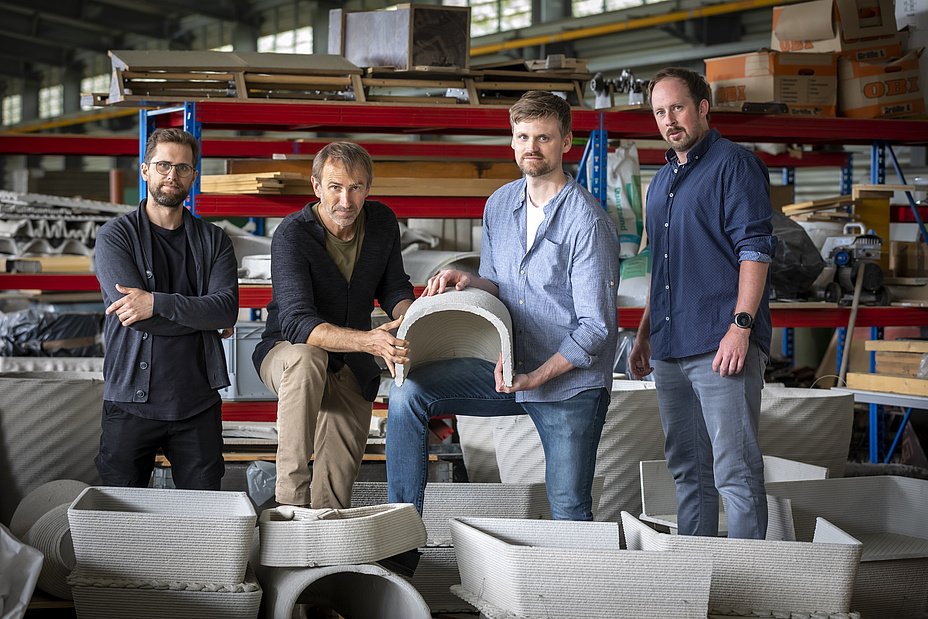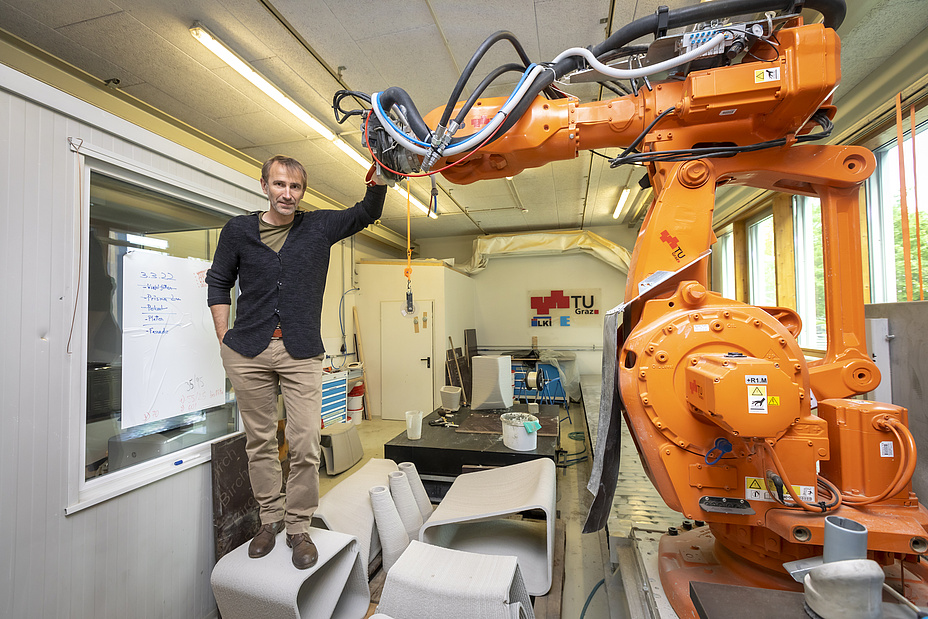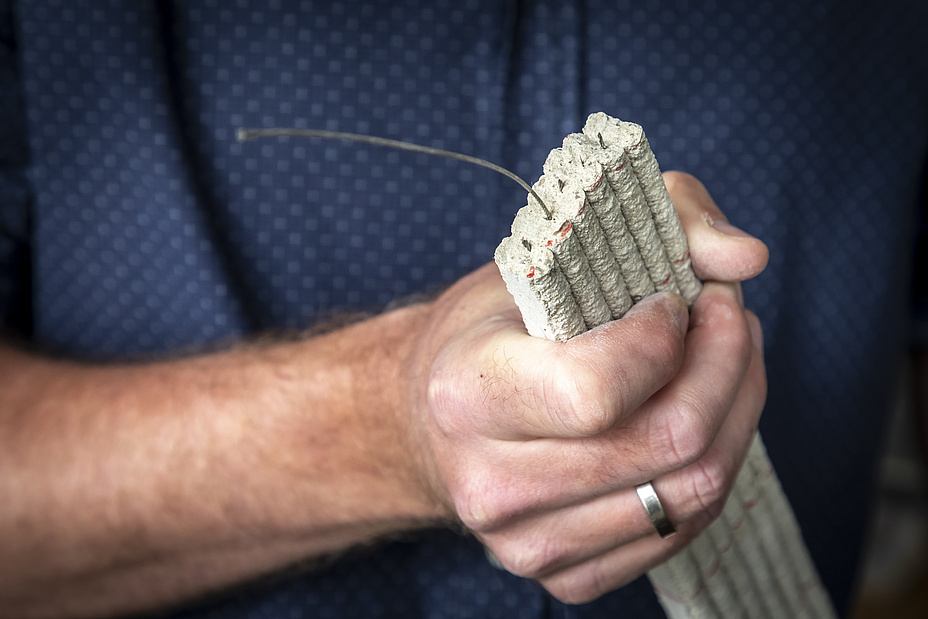Researchers at the Graz University of Technology (TU Graz) are investigating how concrete 3D printing can enable huge material savings for the construction sector, all while slashing CO2 emissions.
Concrete is by and large the most widely used building material in the world but the production of cement, a key ingredient in concrete, is known to emit an abundance of CO2.
A team comprising architects and civil engineers from the University’s Institute of Structural Design has now turned to 3D printing to create concrete elements that are significantly lighter than conventional building slabs. They hope their work can help offset the detrimental effects of construction.
Andreas Trummer, a TU Graz engineer, said, “If we want to make building with concrete more sustainable and climate-friendly, we have to work on new concrete formulations and at the same time use concrete in a more targeted and smarter way.”

The benefits of concrete 3D printing
For as long as concrete construction has been around, humans have relied on formwork such as casting molds to produce building elements. Thanks to 3D printing, for the first time in history, we now have a method of printing concrete walls in novel load-bearing geometries that would otherwise be impossible to fabricate. As well as enabling previously unseen building shapes, this can save significantly on both costs and lead times due to the lack of manual labor.
As TU Graz is now researching, concrete 3D printing also lends itself to material savings. For example, the team recently 3D printed concrete walls just 2cm thick, whereby the material was only extruded where it was needed according to load requirements. They’ve also recently 3D printed optimized recess units that can be used to create lighter concrete slabs.
Georg Hansemann, who studied the field for his doctoral thesis, adds, “Using printed recess units, material savings of up to 40% by volume or 50% CO2 equivalents can thus be made from reinforced concrete slabs.”

TU Graz’s field projects
Looking to utilize their research outside the lab, the TU Graz team recently had its first ‘industrial’ experience at Seehof Castle in Germany, where they 3D printed recess units for the Atelierdach art project.
However, the first time their lightweight concrete elements were used under real construction site conditions was for the ceiling of an underground car park in Nördlingen, Bavaria. Completed in just a few weeks, this project was conducted in partnership with construction firm Eigner Bauunternehmung. Trummer’s research team is currently consulting for a similar project in Vorarlberg, Austria.
Trummer said, “This was a very valuable collaboration for us, because there are many subtleties that can only be recognized in the construction site process.”
The challenge of concrete reinforcements
One of the issues the team is still facing is reinforcing their printed concrete elements. Traditional concrete slabs are simply reinforced with rebars made of steel, but this is much harder when dealing with lightweight slabs with complex intersecting ribs.
To address the issue, the researchers are working with metal processing firm Alpenländische Veredelungs-Industrie to develop new types of reinforcements specifically for 3D printed slabs as part of the ‘City of the Future’ project. In the same project, they’re also working with BOKU to iron out the logistical issues associated with pre-printed concrete elements, including the storage and transportation of the elements.
However, TU Graz has already succeeded in integrating filigree steel reinforcements into some of their more simple 3D printed concrete parts.
“We can directly include a thin steel cable in the printed concrete lines (PCL; the extruded concrete strands) so that reinforcement is directly integrated into the printing process,” said Trummer.

Improving thermal insulation with foamed concrete
Another one of the team’s specialties is in 3D printable foamed concrete materials. To create foamed concrete, the researchers introduce air bubbles into the mix, which slashes the amount of raw concrete material used while also giving the formulation vastly improved thermal insulation.
For the heavy load-bearing sections of a structure, the researchers would still use dense concrete. However, other parts of the structure where more thermal insulation may be required would be 3D printed using foamed concrete, meaning less petroleum-based insulating material would be required.
Despite its extensive research activities, TU Graz isn’t the only institution investigating construction 3D printing. Earlier in May, a group of international researchers produced binder jet 3D printed geopolymer structures capable of competing with structural concrete for various applications. The primary goal of the research was to 3D print metakaolin, a dehydroxylated form of the clay mineral kaolinite, without the use of cement.
Elsewhere, researchers from Nanyang Technological University (NTU Singapore) recently explored the use of recycled glass as a replacement for sand in concrete 3D printing, paving the way for environmentally-friendly building materials. In a bid to make use of glass’ untapped potential, the NTU team created a recycled glass-based concrete mix and used it to 3D print a 40cm-tall concrete bench.
Subscribe to the 3D Printing Industry newsletter for the latest news in additive manufacturing. You can also stay connected by following us on Twitter, liking us on Facebook, and tuning into the 3D Printing Industry YouTube Channel.
Looking for a career in additive manufacturing? Visit 3D Printing Jobs for a selection of roles in the industry.
Featured image shows Robert Schmid, Andreas Trummer, Georg Hansemann and Christoph Holzinger, Institute of Structural Design, TU Graz. Photo via Lunghammer – TU Graz.


